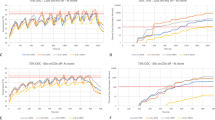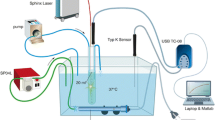Abstract
Purpose
High-power laser lithotripsy can elevate temperature within the urinary collecting system and increase risk of thermal injury. Temperature elevation is dependent on power settings and operator duty cycle (ODC)—the percentage of time the laser pedal is depressed. The objective of this study was to quantify temperature and thermal dose resulting from laser activation at different ODC in an in-vitro model.
Methods
Holmium laser energy (1800 J) was delivered at 30 W (0.5 J × 60 Hz) to a fluid filled glass bulb. Room temperature irrigation was applied at 8 ml/min. ODC was evaluated in 10% increments from 50–100%. Bulb fluid temperature was recorded and thermal dose calculated. Time to reach threshold of thermal injury and maximal allowable energy were also determined at each ODC.
Results
Upon laser activation, there was an immediate rise in fluid temperature with a “saw-tooth” oscillation superimposed on the curves for 50–90% ODC corresponding to periodic activation of the laser. Higher ODC resulted in greater maximum temperature and thermal dose, with ODC ≥ 70% exceeding threshold. Use of 50% compared to 60% ODC resulted in a tenfold increase in time required to reach threshold of thermal injury and an eightfold increase in maximal allowable energy.
Conclusions
Laser activation at higher ODC produced greater fluid temperature and thermal dose. Time to threshold of thermal injury and maximal allowable energy were dramatically higher for 50% compared to 60% ODC at high-power settings. Proper management of laser ODC can enhance patient safety and optimize stone treatment.



Similar content being viewed by others
References
Dauw CA, Simeon L, Alruwaily AF, Sanguedolce F, Hollingsworth JM, Roberts WW, Faerber G, Wolf JS, Ghani KR (2015) Contemporary practice patterns of flexible ureteroscopy for treating renal stones: results of a worldwide survey. J Endourol 29:1221–1230. https://doi.org/10.1089/end.2015.0260
Molina WR, Silva IN, Donalisio Da Silva R, Gustafson D, Sehrt D, Kim FJ (2015) Influence of saline on temperature profile of laser lithotripsy activation. J Endourol 29(2):235–239. https://doi.org/10.1089/end.2014.0305
Aldoukhi AH, Ghani KR, Hall TL, Roberts WW (2017) Thermal response to high-power holmium laser lithotripsy. J Endourol 31(12):1308–1312. https://doi.org/10.1089/end.2017.0679
Wollin DA, Carlos EC, Tom WR, Simmons WN, Preminger GM, Lipkin ME (2018) Effect of laser settings and irrigation rates on ureteral temperature during holmium laser lithotripsy, an in vitro model. J Endourol 32(1):59–63. https://doi.org/10.1089/end.2017.0658
Sourial MW, Ebel J, Francois N, Box GN, Knudsen BE (2018) Holmium-YAG laser: Impact of pulse energy and frequency on local fluid temperature in an in-vitro obstructed kidney calyx model. J Biomed Opt 23(10):1. https://doi.org/10.1117/1.jbo.23.10.105002
Hein S, Petzold R, Schoenthaler M, Wetterauer U, Miernik A (2018) Thermal effects of Ho:YAG laser lithotripsy: real-time evaluation in an in vitro model. World J Urol 36(9):1469–1475. https://doi.org/10.1007/s00345-018-2303-x
Winship B, Wollin D, Carlos E, Peters C, Li J, Terry R, Boydston K, Preminger GM, Lipkin M (2019) The rise and fall of high temperatures during Ureteroscopic Holmium laser lithotripsy. J Endourol 33(10):794–799. https://doi.org/10.1089/end.2019.0084
Hein S, Petzold R, Suarez-Ibarrola R, Müller PF, Schoenthaler M, Miernik A (2020) Thermal effects of Ho:YAG laser lithotripsy during retrograde intrarenal surgery and percutaneous nephrolithotomy in an ex vivo porcine kidney model. World J Urol 38(3):753–760. https://doi.org/10.1007/s00345-019-02808-5
Aldoukhi AH, Hall TL, Ghani KR, Maxwell AD, MacConaghy B, Roberts WW (2018) Caliceal fluid temperature during high-power Holmium laser lithotripsy in an in vivo Porcine model. J Endourol 32(8):724–729. https://doi.org/10.1089/end.2018.0395
Maxwell AD, MacConaghy B, Harper JD, Aldoukhi AH, Hall TL, Roberts WW (2019) Simulation of laser lithotripsy-induced heating in the urinary tract. J Endourol 33(2):113–119. https://doi.org/10.1089/end.2018.0395
William JG, Goldsmith L, Moulton DE, Waters SL, Turney BW (2021) A temperature model for laser lithotripsy. World J Urol 39:1707–1716. https://doi.org/10.1007/s00345-020-03357-y
Class 2 Device Recall Olympus. U.S. Food and Drug Administration (FDA). Initiated June 30, 2021. https://www.accessdata.fda.gov/scripts/cdrh/cfdocs/cfRes/res.cfm?id=188172. Accessed Aug 24, 2021.
Aldoukhi AH, Dau JJ, Majdalany SE, Hall TL, Ghani KR, Hollingsworth JM, Ambani SN, Dauw CA, Roberts WW (2021) Patterns of laser activation during ureteroscopic lithotripsy: effects on caliceal fluid temperature and thermal dose. J Endourol 35(8):1217–1222. https://doi.org/10.1089/end.2020.1067
Sapareto SA, Dewey WC (1984) Thermal dose determination in cancer therapy. Int J Radiat Oncol Biol Phys 10(6):787–800. https://doi.org/10.1016/0360-3016(84)90379-1
Yarmolenko PS, Moon EJ, Landon C, Manzoor A, Hochman DW, Viglianti BL, Dewhirst, (2011) Thresholds for thermal damage to normal tissues: an update. Int J Hyperth 27(4):320–343. https://doi.org/10.3109/02656736.2010.534527
Khajeh NR, Hall TL, Ghani KR, Roberts WW (2021) Pelvicalyceal volume and fluid temperature elevation during laser lithotripsy. J Endourol. https://doi.org/10.1089/end.2021.0383
Aldoukhi AH, Black K, Hall TL, Ghani KR, Maxwell AD, MacConaghy B, Roberts WW (2020) Defining thermal safe laser lithotripsy power and irrigation parameters: in vitro model. J Endourol 34(1):76–81. https://doi.org/10.1089/end.2019.0499
Dau JJ, Hall TL, Maxwell AD, Ghani KR, Roberts WW (2021) Effect of chilled irrigation on Caliceal fluid temperature and time to thermal injury threshold during laser lithotripsy in vitro model. J Endourol 35(5):700–705. https://doi.org/10.1089/end.2020.0896
Dau JJ, Khajeh NR, Hall TL, Roberts WW (2021) Chilled irrigation for control of temperature elevation during ureteroscopic laser lithotripsy: in vivo porcine model. J Endourol. https://doi.org/10.1089/end.2021.0537
Funding
Funding provided through a research grant from Boston Scientific Corporation.
Author information
Authors and Affiliations
Contributions
MM Louters: data collection and analysis, manuscript writing. WW Roberts: project development and management, data analysis, manuscript editing KR Ghani: manuscript editing. JJ Dau: manuscript editing. TL Hall: manuscript editing.
Corresponding author
Ethics declarations
Conflict of interest
WW Roberts has a consulting relationship with Boston Scientific. KR Ghani has consulting relationships with Boston Scientific, Lumenis, Olympus, Coloplast, and Karl Storz. MM Louters, JJ Dau, and TL Hall have no relevant financial or non-financial interests to disclose.
Ethical approval
This was an in-vitro study that did not require ethics approval.
Informed consent
This was an in-vitro study that did not include human participation. Informed consent was not required.
Additional information
Publisher's Note
Springer Nature remains neutral with regard to jurisdictional claims in published maps and institutional affiliations.
Supplementary Information
Below is the link to the electronic supplementary material.
Rights and permissions
About this article
Cite this article
Louters, M.M., Dau, J.J., Hall, T.L. et al. Laser operator duty cycle effect on temperature and thermal dose: in-vitro study. World J Urol 40, 1575–1580 (2022). https://doi.org/10.1007/s00345-022-03967-8
Received:
Accepted:
Published:
Issue Date:
DOI: https://doi.org/10.1007/s00345-022-03967-8




